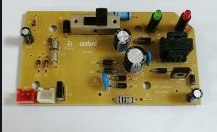In the process of PCBA processing, there are many production processes, which are prone to many quality problems. At this time, it is necessary to continuously improve the PCBA welding method and improve the process to effectively improve the product quality.
PCBA welding
1. Improve the temperature and time of welding
The intermetallic bond between copper and tin forms crystal grains. The shape and size of the crystal grains depend on the duration and strength of the temperature during welding. Less heat during welding can form a fine crystalline structure, forming an excellent welding point with the best strength. PCBA patch processing reaction time is too long, whether it is due to too long welding time or due to high temperature or both, it will lead to a rough crystalline structure, which is gritty and brittle, and has relatively high shear strength. small.
2. Reduce surface tension
The cohesion of tin-lead solder is even greater than that of water, so that the solder is spherical to minimize its surface area (under the same volume, the sphere has the smallest surface area compared with other geometric shapes to meet the needs of the lowest energy state) . The effect of the flux is similar to the effect of the cleaner on the grease-coated metal plate.In addition, the surface tension is also highly dependent on the cleanliness and temperature of the surface. Only when the adhesion energy is much greater than the surface energy (cohesion) can ideal adhesion occur. tin.

3. PCBA board dip tin corner
When the eutectic point temperature of solder is about 35°C higher, when a drop of solder is placed on a hot flux-coated surface, a meniscus is formed. To a certain extent, the ability of the metal surface to dip tin It can be evaluated by the shape of the meniscus. If the solder meniscus has an obvious undercut edge, shaped like a drop of water on a greased metal plate, or even tends to be spherical, the metal is not weldable. Only the meniscus stretched to a size less than 30. It has good weldability at a small angle.
Analysis of the cause of whitening around the pad after PCBA soldering
After PCBA soldering, there will be whitening around the pad, which usually occurs when PCBA is finished wave soldering, cleaning the board, storing and repairing. These white substances are mainly caused by residues.
1. Causes of wave soldering
1. There is thin tin oxide floating on the surface of the wave crest;
2. The preheating temperature or curve parameters are inappropriate;
3. The flux flow rate is too high, the preheating temperature is low, and the tin-eating time is too short;
4. Flux composition, inspection test and certification.
2. Causes after cleaning
1. Rosin in flux:
Most of the white substances produced after cleaning, storage, and solder joint failure are inherent rosin in the flux.
2. Rosin denatured substance:
This is the substance produced by the reaction between rosin and flux during the soldering process of the board, and the solubility of this substance is generally very poor, it is not easy to be cleaned, and stays on the board to form a white residue.
3. Organic metal salt:
The principle of removing oxides on the soldering surface is that organic acids react with metal oxides to form metal salts that are soluble in liquid rosin, which forms a solid solution with rosin after cooling, and is removed with the rosin during cleaning.
4. Metal inorganic salt:
These may be metal oxides in solder and flux or halogen-containing activators in solder paste, halogen ions in PCB pads, halogen ion residues in the surface coating of components, and halogen-containing materials in FR4 materials that are released at high temperatures. The substances produced by the reaction of halide ions generally have very little solubility in organic solvents. If the cleaning agent is selected appropriately, the flux residues may be removed; once the cleaning agent is not matched with the residues, it may be difficult to remove these metal salts, leaving white spots on the board.
The whitening of the pad after PCBA soldering is mainly caused by the residual flux and not cleanly. It needs to be cleaned after soldering.